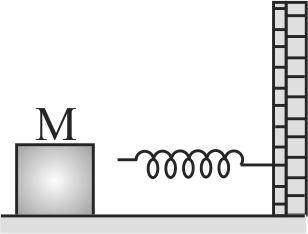355604
A massless spring of force constant \({1000 {~N} / {m}}\) is compressed a distance of \(20\,cm\) between discs of \(8\,kg\) and \(2\,kg\), spring is not attached to discs. The system is given an initial velocity \({3 {~m} / {s}}\) perpendicular to length of spring as shown in figure. What is ground frame velocity of \(2\,kg\) block when spring regains its natural length.
355604
A massless spring of force constant \({1000 {~N} / {m}}\) is compressed a distance of \(20\,cm\) between discs of \(8\,kg\) and \(2\,kg\), spring is not attached to discs. The system is given an initial velocity \({3 {~m} / {s}}\) perpendicular to length of spring as shown in figure. What is ground frame velocity of \(2\,kg\) block when spring regains its natural length.
355604
A massless spring of force constant \({1000 {~N} / {m}}\) is compressed a distance of \(20\,cm\) between discs of \(8\,kg\) and \(2\,kg\), spring is not attached to discs. The system is given an initial velocity \({3 {~m} / {s}}\) perpendicular to length of spring as shown in figure. What is ground frame velocity of \(2\,kg\) block when spring regains its natural length.
355604
A massless spring of force constant \({1000 {~N} / {m}}\) is compressed a distance of \(20\,cm\) between discs of \(8\,kg\) and \(2\,kg\), spring is not attached to discs. The system is given an initial velocity \({3 {~m} / {s}}\) perpendicular to length of spring as shown in figure. What is ground frame velocity of \(2\,kg\) block when spring regains its natural length.

